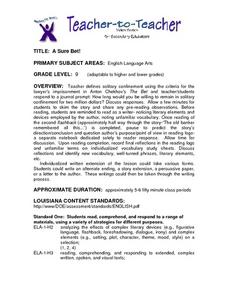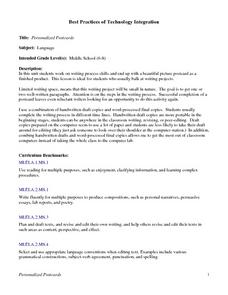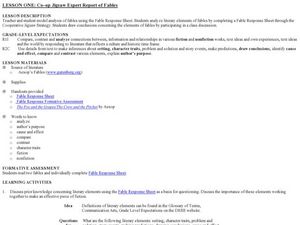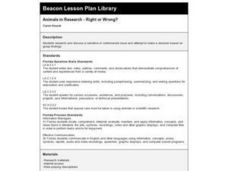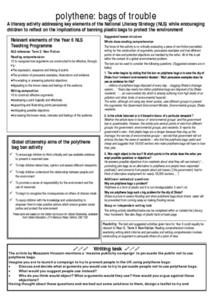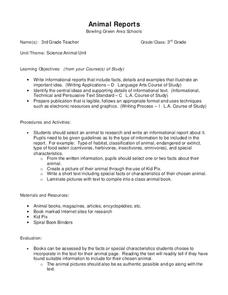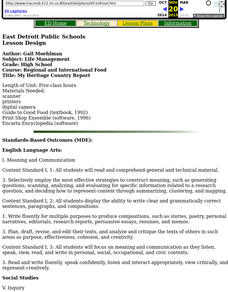Curated OER
A Sure Bet!
Ninth graders analyze Chekhov's "The Bet". They repsond to a journal quesiton and use examples from the novel. In groups, they take on different roles analyzing the novel and then write one of my prompts to complete the lesson.
Curated OER
Connecting the Dots? Geometry and Architecture
Learners examine the connection between geometry and architecture. In this geometry and architecture lesson, students view a video which details a geometry class design project. Learners then use the Internet in a scavenger hunt to find...
Curated OER
Exploring Satire - Jonathan Swift
Students study about satire and find examples Part One of GULLIVER'S TRAVELS. They then write an essay about the examples they found and how the writer used satire in his literary work.
Curated OER
My Deaf American Hero
Students study and discuss famous deaf people that are role models for students who are deaf. They research a famous deaf American and create a ten frame multimedia presentation to showcase the information.
Curated OER
"The Scientist and The Prince: Two Interesting Early Pennsylvania Immigrants
Young scholars examine immigrants including why people immigrated to America and their places of origin. In this immigrants instructional activity high schoolers analyze the importance of immigrants and the obstacles that they...
Curated OER
Global Warming
Students explore global warming. In this science lesson, students research global warming. Students work in small groups to create a presentation about global warming.
Curated OER
Personalized Postcards
Students create and send postcards to friends and family members. Using actual photographs, they write a rough draft and final draft of a paragraph and print it out to glue onto a postcard template to mail to their friend or family member.
Curated OER
Cooperative Jigsaw Expert Report of Fables
Students research literary elements of fables. In this literature instructional activity, students analyze literary elements of fables. Students work collaboratively using a jigsaw strategy to analyze literary elements.
Curated OER
Animals in Research - Right or Wrong?
Young scholars research animal testing in scientific research. They role-play a research scientist, teacher, animal rights activist, or cosmetics manufacturer, and develop an argument for or against animal testing.
Curated OER
Properties of Waves
Third graders observe and investigate wave properties and compare the properties of particles and waves. They fill a pie pan half full with water, place a toothpick in the center of the pie pan, then drop a marble into the pan and...
Curated OER
Rhetorical Devices
Eleventh graders consider rhetorical devices in speeches and then make an informed selection of effective rhetorical devices for a controversial topic presentation. Students present their findings using presentation software.
Curated OER
Cows That Type Friendly Letters
Students engage in a lesson that introduces the parts of a letter. The lesson is taught using a powerpoint presentation with the purpose of integrating technology into instruction. Students create a letter and thinking map to challenge...
Curated OER
TEACHING STUDENTS WITH DISABILITIES
Students are introduced to teaching strategies for meeting the needs of students with disabilities in general education settings. Teachers become familiar with the various modifications, interventions, accommodations and strategies that...
Curated OER
The Bill of Rights: Debating the Amendments
Students explore the Bill of Rights. In this U.S. Constitution lesson, students participate in classroom debate regarding the first 10 amendments to the Constitution. Students then vote for the amendments they would like to ratify.
Curated OER
Cause and Effect
Students examine the role of the Prince's Trust. In this British charities lesson, students research selected websites to determine the type of charity work that is performed by the Prince's Trust. Students also research the work of...
Curated OER
Reporting Live From...
Students examine the many disasters in West Virginia. In this US history lesson, students write about and give an oral presentation of one of the disasters as if they were reporters.
Curated OER
Research Activity for the Legal Brief
Pupils use extensive information about previous cases with related themes and depositions on the Street Law web site to gather information that will be used to write an effective appeals brief for whichever party in the case their group...
Curated OER
Polythene: Bags Of Trouble
Students investigate the use of polythene bags in the community and measure the possible impact upon the environment. They conduct research using a variety of resources. The information is used in order to create an evaluative opintion...
Curated OER
White Horse Estate Agents
In this Language Arts worksheet, students write a description of a house. Students include information about the downstairs, upstairs, garden, and garage.
Curated OER
Magazine Sales Talks
Students role-play to determine the best types of magazines that should be purchased for their media center. They create a sales presentation for a particular magazine in small groups. As they listen to each presentation they evaluate...
Curated OER
Animal Reports
Third graders choose an animal to research and write a report about. They determine the animals' habitat, animal classification, whether it is endangered or extinct, and the type of food it eats. Also, they add any special...
Curated OER
My Heritage Country Report
High schoolers list five food dishes that are part of their family's heritage. Each student then does research of a country and a recipe (possibly a family recipe). With the help of members of his/her kitchen group, the student prepares...
Curated OER
Rainforest Problem
Third graders use a hypothetical story in order to create a context for the lesson. The story presents a problem that needs to be solved. They write a letter to a government official as part of the lesson.
Curated OER
Pictorial Portfolio
High schoolers develop a pictorial portfolio of important assignments, projects and activities through their high school years. They use a camera and decide what makes a good photograph. Students organize their photographs into a...


